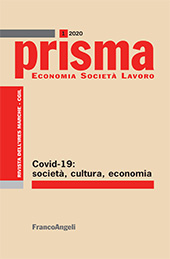Non restiamo a casa da 4 anni : la pandemia nelle aree abitative temporanee del post-sisma 2016-2017 dell'Appennino Centrale
77-94 p.
Nell'ambito dell'ampia riflessione interdisciplinare sul tema dell'abitare stimolata dalla diffusione mondiale del Coronavirus, questo contributo si propone di indagare il rapporto tra l'emergenza pandemica e le pratiche abitative postdisastro. L'articolo descrive la ricerca etnografica comparativa all'interno di due aree abitative temporanee della provincia di Macerata, installate a seguito del terremoto che ha duramente colpito l'Appennino centrale nel 20162017. Il contributo analizza l'impatto delle misure restrittive imposte dalla normativa italiana su queste "nuove" forme abitative e mette in evidenza alcune aree critiche, considerate sia in un'ottica domestica che in una più ampia territoriale. Sebbene l'emergenza pandemica inasprisca certamente le criticità, esse sono riconducibili alle più ampie vulnerabilità dei territori colpiti dal terremoto, la cui analisi non può prescindere dall'adozione di una prospettiva storicizzata e diacronica.
Dopo aver riconosciuto il permanere di una "doppia emergenza" in questi territori, le conclusioni suggeriscono l'importanza di considerare, analiticamente e pragmaticamente, il fattore temporale del "ritorno alla normalità", legato principalmente alla ricostruzione delle case distrutte dal terremoto. [Testo dell'editore].
As part of the broad interdisciplinary reflection on the issue of housing stimulated by the worldwide spread of Coronavirus, this paper aims to investigate the relationship between the pandemic emergency and postdisaster housing practices. It describes comparative ethnographic research within two temporary housing areas in the province of Macerata, installed following the earthquake that severely hit the central Apennines in 20162017. The paper analyses the impact of the restrictive measures imposed by the Italian legislation on these "new" forms of housing and highlights some critical areas, considered both in a domestic view and in a more extensive territorial one. Although the pandemic emergency certainly exacerbates the critical issues, they are attributable to the broader vulnerabilities of the territories hit by the earthquake, whose analysis cannot ignore the adoption of a historicised and diachronic perspective.
After recognising the persistence of a "double emergency" in these territories, the conclusions suggest the importance of considering, analytically and pragmatically, the time factor of "return to normality", primarily related to the reconstruction of the houses destroyed by the earthquake. [Publisher's text].
Fa parte di
Prisma : economia, società, lavoro : 1, 2020-
Articoli dello stesso fascicolo (disponibili singolarmente)
-
Informazioni
Codice DOI: 10.3280/PRI2020-001006
ISSN: 2036-5063
PAROLE CHIAVE
- Housing, terremoto, pandemia, emergenza, temporalità
- Housing, earthquake, pandemic, emergency, temporality



